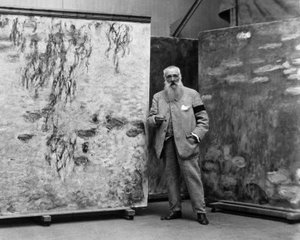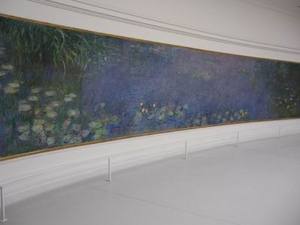From afar, the exhibition called Monet’s Water Lillies at the Nelson-Atkins Museum of Art in Kansas City has a lot of good things going for it.
But it also, I believe, has a downside or two…and I hope this is not the way of the future there. Until now, I’ve been mostly impressed by the museum under new director Julian Zugazagoitia (see here and here).
 The exhibit, which opens Apr. 8, reunites a Monet triptych, whose panels have long since been acquired by three museums, for the first time in three decades. The 14-feet wide, 6-feet-tall paintings are hung together, in a panorama, as Monet intended, not separated by space and not surrounded by other paintings — similarly, as I recall, to the way another water lillies series is hung at l’Orangerie (below) in Paris (and, maybe an old installation at the Museum of Modern Art?).
The exhibit, which opens Apr. 8, reunites a Monet triptych, whose panels have long since been acquired by three museums, for the first time in three decades. The 14-feet wide, 6-feet-tall paintings are hung together, in a panorama, as Monet intended, not separated by space and not surrounded by other paintings — similarly, as I recall, to the way another water lillies series is hung at l’Orangerie (below) in Paris (and, maybe an old installation at the Museum of Modern Art?).
In nearby galleries, visitors will see archival photographs and a rare 1915 film that shows Monet painting in his garden at Giverny.
The curators have done their scholarship, too. From new conservation studies, they believe that Monet changed the composition over the years, and the exhibition will explore his process.
You can read more in the press release.
 So what’s not to like? Background music, for one thing. The museum is piping it in to gallery displaying the triptych. What kind I do not know, but while I love music as much as paintings I don’t need or want background music to go with my Monet.
So what’s not to like? Background music, for one thing. The museum is piping it in to gallery displaying the triptych. What kind I do not know, but while I love music as much as paintings I don’t need or want background music to go with my Monet.
What would be the point?
These Monet Water Lillies in particular can hold their own. As an AP article appropriately quotes Ann Temkin, MoMA’s chief curator of paintings and sculpture: “What’s amazing about them is the mood they create in the room where they’re installed. It’s a magical one. It becomes a very quiet place. The visitors become quite contemplative.” Here’s the AP article, printed in the in the Seattle Times.
I also have minor questions about this, as the Kansas City Star describes it:
Bound to be a big hit is a touch-screen paint program, where visitors can create their own water lillies paintings with virtual brushes and colors and email the finished works to their home computers and to an online gallery on the Nelson’s website.
And:
…[the exhibit] will not only have X-rays and that touch-screen paint program, it will also have books and a “touchable” version of the “Water Lilies,” created by associate conservator of painting Mary Schafer.
Schafer’s 20-by-60-inch canvas, loosely divided into vertical strips, provides a chronological account of the way Monet built his canvas from the white ground to thick applications of pigment for the water lilies to the thin washes he applied over them.
Viewers will be encouraged to feel the surface texture of Schafer’s painting, which she fully expects will get dirty over the course of the show.
It’s that touching part that bothers me most (though I wonder if people will conclude that they can paint as well as Monet!). Later in the show — it runs until August — Schafer plans to show children how to clean that painting, in the course of which they’re also supposed to learn why they can’t touch the real thing. Good luck with that… months later. And who’s to say the children who did the touching will later do the learning? Probably not, as a matter of fact.
There’s also a bit more on this in the Basehor Sentinel and the AP story.
I wonder, too, what signals museums are sending with some new “add-ons.” Maybe these are fine — I’d like to see them before weighing in definitively — but are museums saying that art, even great art, is not enough. As I understand this exhibit, visitors exit through the “active” and “interactive” areas; they don’t leave with that marvelous feeling of peace and thoughtfulness that Water Lillies creates.
And that’s a bit of a shame.
